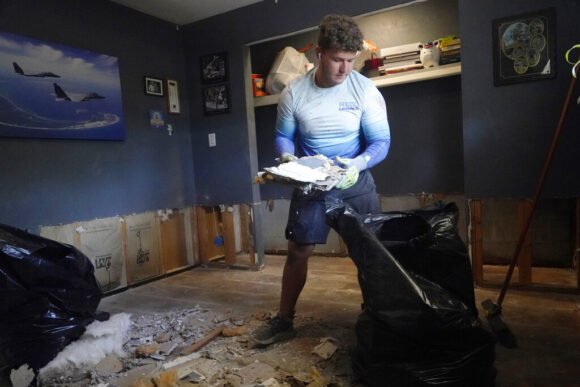The National Flood Insurance Program has approved a waiver that will allow some policyholders flooded by Hurricane Ian to receive advance payments of as much as $20,000 – with few strings attached.
“The payments will get to the customer, but they have to ask for it,” said David Thompson, a longtime Florida insurance agent, now a consultant and trainer with the Florida Association of Insurance Agents, who has seen the program in action in previous storms.
Florida’s chief financial officer, Jimmy Patronis, announced that the NFIP had accepted his and the Florida governor’s request for the waiver, which the program often agrees to after major flood events. The plan can grant a $5,000 payment before an inspection, with minimal documentation, or $20,000 with more documentation.
The program works like this, Thompson and the NFIP Claims Manual explained: Policyholders must report the flood loss to their insurance agent or insurance company. The insurer should verify that the property is covered by an NFIP flood policy, and obtain a statement from the policyholder noting the height of the floodwaters in the structure.
An adjuster or claims professional will then follow up with a phone call to the insured. In most cases, an NFIP adjuster will be involved in the process, but a physical inspection of the property is not required, officials said.
For the larger payment, policyholders should send photographs showing the height of the floodwaters and damage to the building and contents. Documentation on out-of-pocket expenses is also helpful, the NFIP manual said. Policyholders have 60 days after the flood event to report their losses, but the Federal Emergency Management Agency, which oversees the NFIP, often extends the deadline after major storms, Thompson said.
Later, once an adjuster physically inspects the property and obtains more extensive documentation, NFIP may also provide advances of 25% or 50% of the policy coverage limits. The standard policy deductible applies.
Thompson, in a posting on the FAIA website, explained that it’s to the policyholders’ benefit to note that the advance payment is to be used for contents and personal belongings. If the check is for structural repairs, NFIP is obligated to include the mortgage company, which could slow the process down.
“Agency staff should be proactive in advising customers of the possibility of an advance under certain circumstances,” Thompson wrote. “If the agency is involved in the claims process, it should help facilitate a possible advance of funds with the adjuster and customer.”
Information about the advance payment program can be seen in the NFIP Claims Manual, page 216.
Photo: Justin Spiezo, 20, picks up debris after cutting out waterlogged walls in his bedroom on Monday, Oct. 3, 2022, in Fort Myers, Florida. The canal behind his home crested at 12 feet on Wednesday as Hurricane Ian ravaged the area. (AP Photo/Marta Lavandier)
Topics Flood
Was this article valuable?
Here are more articles you may enjoy.



 Wildfires Are Upending Some of the Safest Bets on Wall Street
Wildfires Are Upending Some of the Safest Bets on Wall Street  USAA to Lay Off 220 Employees
USAA to Lay Off 220 Employees  North Carolina Adjuster and Son Charged With Embezzlement in Roof Jobs
North Carolina Adjuster and Son Charged With Embezzlement in Roof Jobs  DeSantis Signs Bill Barring Local Worker Heat Protection Measures
DeSantis Signs Bill Barring Local Worker Heat Protection Measures 

